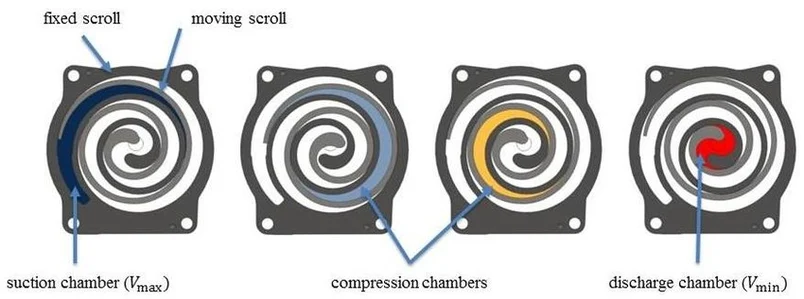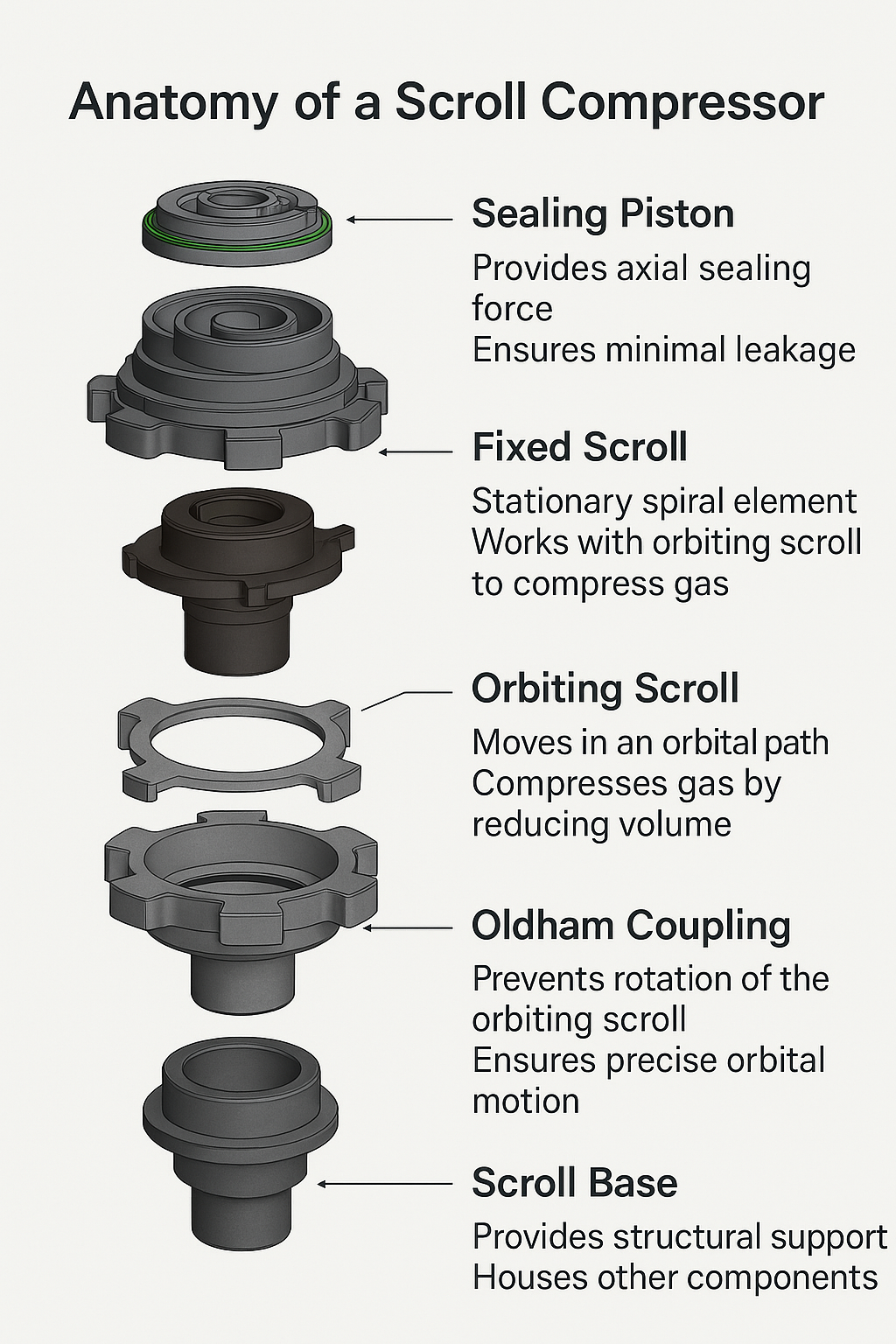Компрессоры прокрутки могут быть не нарицательными, но они являются тихими электростанциями для многих систем, на которые мы полагаемся ежедневно. От поддержания прохлаждения вашего дома до обеспечения бесперебойной работы промышленных процессов, эти устройства заслужили свое место в качестве краеугольного камня современной технологии охлаждения и сжатия. Известные своей эффективностью, долговечностью и инновационным дизайном, компрессоры прокрутки предлагают убедительную альтернативу традиционным вариантам, таким как поршневые или вращательные винтовые компрессоры. В этом глубоком погружении мы рассмотрим, как они работают, их выдающиеся преимущества и где они имеют значение - будь то инженер, техник HVAC или просто любопытно, что гудит в вашем кондиционере.
Что такое компрессор свитка?

В своем ядре компрессор прокрутки-это тип положительного компрессора смещения, который использует два взаимосвязанных спиральных свитков в форме спиральной формы для сжатия газа-чаще всего хладагента в системах охлаждения, хотя некоторые модели обрабатывают воздух. Один свиток остается фиксированным, надежно закрепил на месте, в то время как другой вращается вокруг него круговым движением, не вращаясь на своей оси. Это уникальное действие ловит газ в карманах, которые сжимаются, когда они спирали внутрь, сжимая газ, прежде чем выпустить его при высоком давлении через центральную розетку.
В отличие от поршневых компрессоров, которые полагаются на изменчивое, возвращающее движение или вращающиеся винтовые компрессоры с их скручивающими роторами, скручиваемые компрессоры прокрутки работают с гладким, непрерывным потоком. Этот дизайн сводит к минимуму движущиеся части - просто вращающийся свиток, двигатель и несколько вспомогательных компонентов - что делает их простыми и надежными, чем многие альтернативы. С момента своего коммерческого дебюта в 1980 -х годах, впервые представленных такими компаниями, как Copeland, Scroll Compressors стали одним из основных продуктов в области HVAC, охлаждения и нишевых промышленных применений.
Как работает компрессор свитка?

Магия компрессора прокрутки лежит в его элегантной, почти гипнотической операции. Вот подробный разрыв процесса:
- Потребление газа: Газ низкого давления попадает через впускной порт на внешнем краю свитков. В системе HVAC это, как правило, хладагент, такой как R-410A, притяженный из испарителя.
- Захват газа: По мере того, как вращающийся свиток движется-вызванный электродвигателем и коленчатым валом-он образует карманы в форме полумесяца между двумя свитками. Эти карманы запечатывают газ, не позволяя ему сбежать наружу.
- Фаза сжатия: Эрбияющее движение неуклонно уменьшает размер этих карманов, сжимая газ, когда оно подталкивается к центру. Это происходит примерно в течение примерно двух до двух с половиной вращений, с несколькими карманами одновременно сжимается для бесшовного потока.
- Увольнять: Как только газ достигает центра, теперь при высоком давлении, он выходит через разрядный порт в фиксированной прокрутке. Не возвратный клапан часто гарантирует, что обратный цепь нарушает цикл.
- Непрерывный цикл: Процесс повторяется без перерыва, предоставляя устойчивый поток сжатого газа без пульсации - в отличие от прерывистых всплесков поршневых компрессоров.
Это жидкое движение - это то, что отличает прокрутки компрессоров. Согласно SciEnceRect, их способность сжимать газ на нескольких этапах в течение одного цикла повышает термодинамическую эффективность, минимизируя потерю энергии. Некоторые конструкции даже включают в себя уплотнения наконечника-намельку на краях прокрутки-чтобы уменьшить утечку, хотя высокое производство часто делает их необязательными.
Анатомия комбиссора прокрутки

Простота комбрессора прокрутки - это его сила. Ключевые компоненты включают:
- Фиксированная прокрутка: Стационарная спираль, обычно сделанная из чугуна или алюминия, прикрепленная к корпусу.
- Вращающийся свиток: Перемещающийся аналог, подключенный к двигателю через коленчатый вал или эксцентричный вал, орбита со скоростью до 3600 об / мин в некоторых моделях.
- Электродвигатель: Powers Orbiting Scrolk, часто однофазный или трехфазный двигатель в зависимости от размера системы.
- Жилье: Надежный корпус, который выравнивает свитки с точностью микронного уровня и содержит хладагент или воздух.
- Входные и выходные порты: Стратегически расположен для оптимизации потока газа, часто с фильтрами или глушителями в моделях обработки воздуха.
Усовершенствованные версии могут включать в себя впрыск масла для смазки в холодильных единицах или плавников с воздушным охлаждением для рассеивания тепла. Бессловные модели, как подчеркивает Atlas Copco, полностью устраняют смазку, обслуживая отрасли, нуждающиеся в воздухе без загрязняющих веществ.
Почему сияют компрессоры прокрутки: главные преимущества
Компрессоры прокрутки приносят набор преимуществ, которые объясняют их широкое распространение:
- Энергоэффективность: Rasmech ссылается на исследование Университета Пердью, показывающее, что компрессоры прокрутки используются примерно на 25% меньше энергии, чем по возвращению моделей. Их непрерывное сжатие позволяет избежать энергии на стартовой стойке поршневых систем.
- Шепокнутая операция: Орбитальное движение дает минимальную вибрацию, сохраняя уровни шума всего 48-55 DBA-по сравнению с тихой разговором. Это делает их идеальными для домов, офисов или больниц.
- Низкое обслуживание: С одним движущимся свитком и без клапанов или поршней для изнашивания, обслуживание - это бриз. Без масляные варианты, за Atlas Copco, полностью изменяются нефть, полностью сокращают затраты.
- Непревзойденная надежность: Меньше деталей означают меньше точек неудачи. Со временем свитки могут даже «носить», ужесточая допуски и повышая производительность, в отличие от ношения, как поршневые кольца.
- Жидкая толерантность: ScienceDirect отмечает, что их способность обрабатывать небольшое количество жидкого хладагента - общая проблема в охлаждении - без повреждения, в отличие от многих конкурентов.
Обратная сторона: ограничения знать
Свит -компрессоры не безупречны. Вот что взвесить:
- Более высокая предварительная стоимость: Точная обработка свитков повышает начальные цены-иногда на 20-30% больше, чем основные поршневые единицы.
- Ремонтные задачи: Плотные допуски означают, что поврежденный свиток часто требует полной замены, а не ремонта, хотя сбои редки.
- Потолок емкости: Они достигают около 60 тонн охлаждающей способности, что делает их менее идеальными для массивных промышленных потребностей, когда винт или центробежные компрессоры вступают во владение.
Где прокрутки компрессоров оказывают влияние
Их универсальность сияет по приложениям:
- Системы HVAC: Найден в жилых системах разделения, подразделениях на крыше и тепловых насосах, ценится за тишину и эффективность. 3-тонное домашнее блок переменного тока может напевать с эффективностью 70% благодаря компрессору прокрутки.
- Охлаждение: Питание чиллеров для холодного хранения или пивоваренных заводов, где их жидкая толерантность обеспечивает надежность. Представьте себе винодельню, поддерживающую 55 ° F, с точностью точностью.
- Медицинская и продовольственная промышленность: Бесплатные компрессоры прокрутки обеспечивают чистый воздух для вентиляторов или упаковку с пищевыми продуктами, соответствующие строгим нормативным стандартам.
- Автомобиль: Компактные блоки свитков охлаждают каюты электромобилей, плотно прилегая под капюшонами, где пространство плотное.
Возьмите пример реального мира: небольшая пивоварня с использованием воды с копченом свитков для охлаждения сусла во время ферментации. Устойчивая мощность сохраняет точную температуру, в то время как тихая операция позволяет персоналу работать без отвлечения.
Зачем прокручивать компрессоры сегодня значение
В эпоху роста затрат на энергию и экологического направления, прокрутки компрессоров доставляют. Их эффективность сокращает счета за коммунальные услуги, в то время как без масла модели соответствуют целям устойчивости, избегая проблем с утилизацией нефти. Как отмечает Расмач, их 25% экономия энергии по сравнению с поршневыми компрессорами может переводить в тысячи долларов в год на объект среднего размера. Между тем, их надежность снижает время простоя - критический фактор в отраслях, где считается каждая минута.
Выбор правильного компрессора прокрутки

Выбор компрессора прокрутки означает соответствие его потребностям:
- Емкость: 5-тонное устройство подходит для небольшого офиса; 20 тонн могут охладить фабричный пол.
- Тип: Смазовать маслом для охлаждения, без масла для чистого воздуха.
- Шум: Проверьте рейтинги DBA, если тишина - это ключ - 48 DBA Beats 60 DBA в домашней обстановке.
Последние мысли
Компрессоры прокрутки могут работать за кулисами, но их влияние находится в современной жизни. Их сочетание эффективности, тихой надежности и адаптивности делает их разумным выбором для проблем с охлаждением и сжатием. Независимо от того, модернизируете ли вы систему HVAC, разработаете настройку охлаждения или исследуете промышленные обновления, компрессоры прокрутки предлагают проверенное решение. Хотите увидеть их в действии? Подключитесь к эксперту по компрессору, чтобы найти идеальное подходящее для вашего проекта - и разблокировать тихую силу технологии прокрутки!
